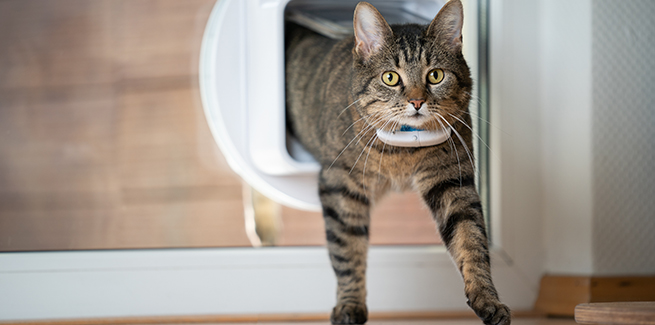Study: Free-roaming pet cats can spread parasites to wildlife

It’s common for pet cats who spend time outdoors to return with the “gift” of the occasional small bird or mammal. But new research from the University of British Columbia (UBC) suggests that those same cats may be leaving an even more unwelcome “gift” behind while out on their rambles—in the form of a potentially deadly parasite.
The new study suggests that free-roaming domestic cats play a significant role in the spread of the Toxoplasma gondii to wildlife—especially in densely populated urban areas.
Using data compiled from 202 published studies, the researchers examined 45,079 cases of toxoplasmosis in wild mammals—the first study to analyze so many wildlife species on a worldwide scale. The disease has been linked to nervous system disorders, cancers, and other chronic conditions.
One infected cat can excrete as many as 500 million Toxoplasma oocysts (or eggs) in just two weeks—which can then live for years in soil and water with the potential to infect any bird or mammal, including humans.
It’s a serious One Health issue with far-reaching implications, and the authors suggest that healthy ecosystems may provide part of the solution. NEWStat reached out to lead researcher Amy Wilson, PhD, DVM, an adjunct professor on the UBC faculty of forestry, to find out more.*
*This interview has been edited and condensed.
NEWStat: What tipped you off that there might be a link between free-roaming domestic cats and the spread of Toxoplasma gondii to wildlife?
Amy Wilson: There has been a growing recognition that domestic cats are the most likely felid (a member of the cat family) to be driving wildlife toxoplasma infections. This suspicion is based on the fact that domestic cats outnumber wild felids by several orders of magnitude, but also from field data and simulation studies. Because cat densities are not well characterized, we tested this hypothesis indirectly using other available geographic information such as human density.
Wild felids avoid human environments and so if wildlife toxoplasma infections are higher in areas with greater human density it suggests domestic cats are the link, whereas it would be the opposite pattern if wild felids were the main source.
NEWStat: What wildlife species are most at risk from Toxo spread from domestic cats?
AW: New information on the health impacts of Toxo in wildlife is constantly emerging as there are species that are very sensitive and have high mortality risks (e.g., Australian marsupials, New World monkeys, marine mammals) and then you have the long-term effects of a chronic infection that are much harder to measure but have ranged from increased risk of trauma on roads to increasing mortality rates from other pathogens.
NEWStat: You write that healthy ecosystems protect against these types of pathogens. How?
AW: This is a key One Health question. Healthy ecosystems can help reduce the levels of pathogens in the environment and reduce infection opportunities by filtering out pathogens.
For example, in the case of Toxoplasma gondii, ecosystems that can sustain populations of native predators prevent large numbers of domestic cats from roaming into important wildlife areas which could lead to lower pathogen inputs into the environment.
For pathogens that are present, vegetated landscapes with healthy populations of soil bacteria and invertebrates can filter out or inactivate pathogens. This is in contrast to bare soil or concrete where pathogens can sit on the surface or be taken by runoff into aquatic habitats.
NEWStat: How can veterinarians help mitigate the problem?
AW: Veterinarians are at the front lines of public education regarding animal and public health, and we are best suited to communicate this message. The free-roaming cat issue presents a really exciting opportunity to implement evidence-based recommendations and demonstrate our profession’s commitment to One Health objectives.
NEWStat: How should veterinarians advise clients who own free-roaming cats but who may resist limiting what they perceive as their pet’s freedom and natural instincts to hunt?
AW: As a veterinarian, I have had this conversation hundreds of times with cat owners. Clearly, it needs to be framed differently for different owners, but . . . there are several points that resonate with owners [including]:
- Feline welfare. A single ER bill can equate to several years of feline wellness appointments or force a family to make a heart-wrenching decision. Therefore, from a preventive medicine perspective, it is important to fully educate owners on one of the most impactful decisions they could make for their pets.
- Impact on wildlife welfare and conservation. Even conservative estimates suggest that cats kill billions of wildlife every year in the US alone. For example in the US, cats kill three times more birds than all other direct causes of mortality combined. This is one of the contributing factors to the crisis of biodiversity loss that we are experiencing.
- Public health risks. Outdoor cats have higher parasitic levels than indoor cats, so when they defecate in people’s yards or playgrounds, other members of the community, especially children, are unknowingly exposed to parasites. The understanding of these parasites is constantly evolving and paradigms that veterinarians formerly believed have been proven to be false. For example, we now know that cats can shed toxoplasma repeatedly and toxoplasma infections are not protective and in fact can have serious implications even for healthy people. Few people understand the elevated zoonotic risk associated with free-roaming cats and it is important that veterinarians educate them.
As veterinarians, the free-roaming cat issue is an incredible opportunity for us to contribute to the welfare of wildlife and cats, both of which are often marginalized. Progress in this area is a win for everyone. Veterinary professionals are positioned to make unique and impactful contributions to public health and conservation. Effective conservation requires pragmatism, scientific literacy, and a passion for animal welfare, traits which are ingrained into our profession.
Find out more about caring for cats of all lifestyles in the 2021 AAHA/AAFP Feline Life Stage Guidelines.
Photo credit: © Nils Jacobi



